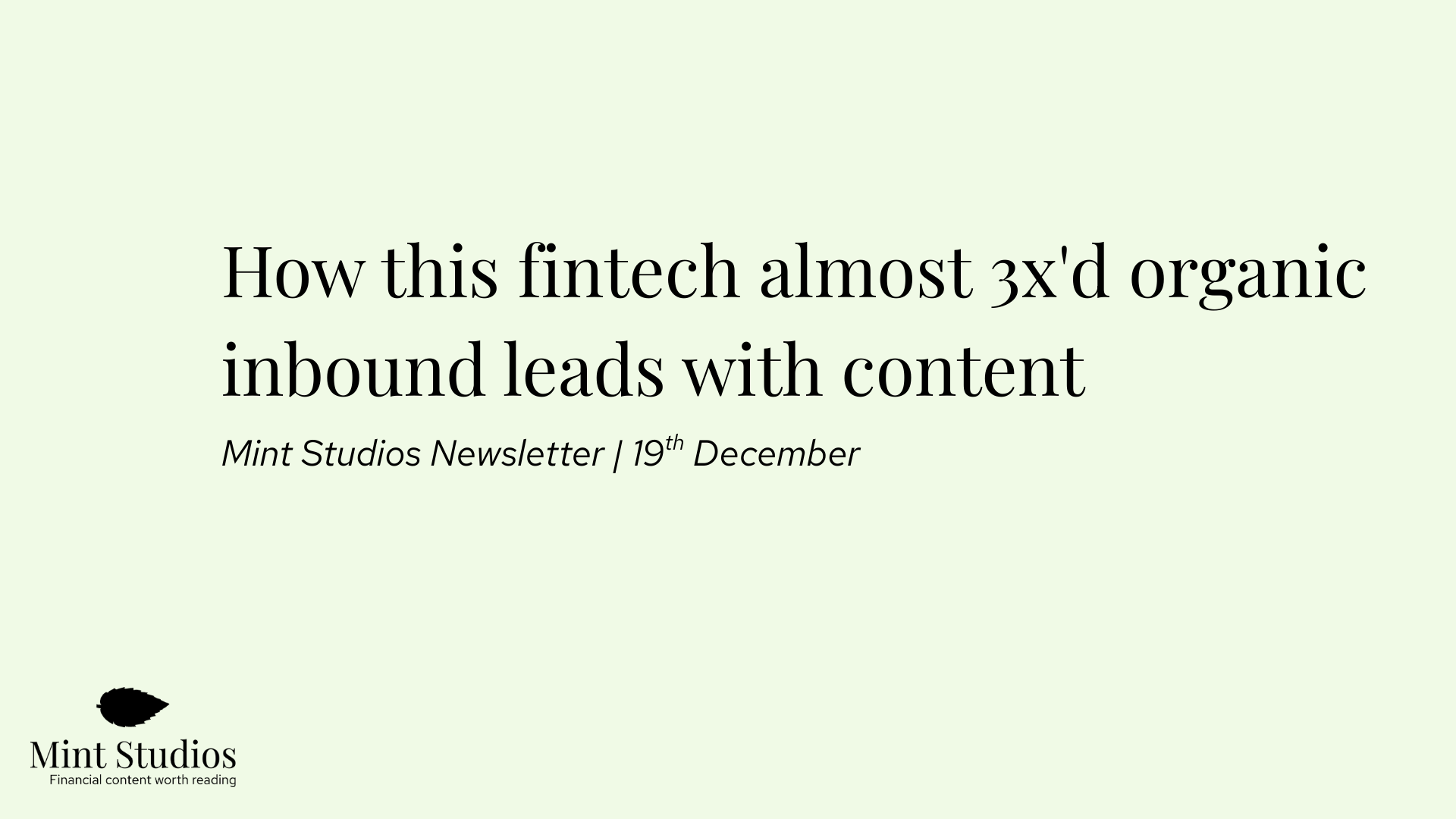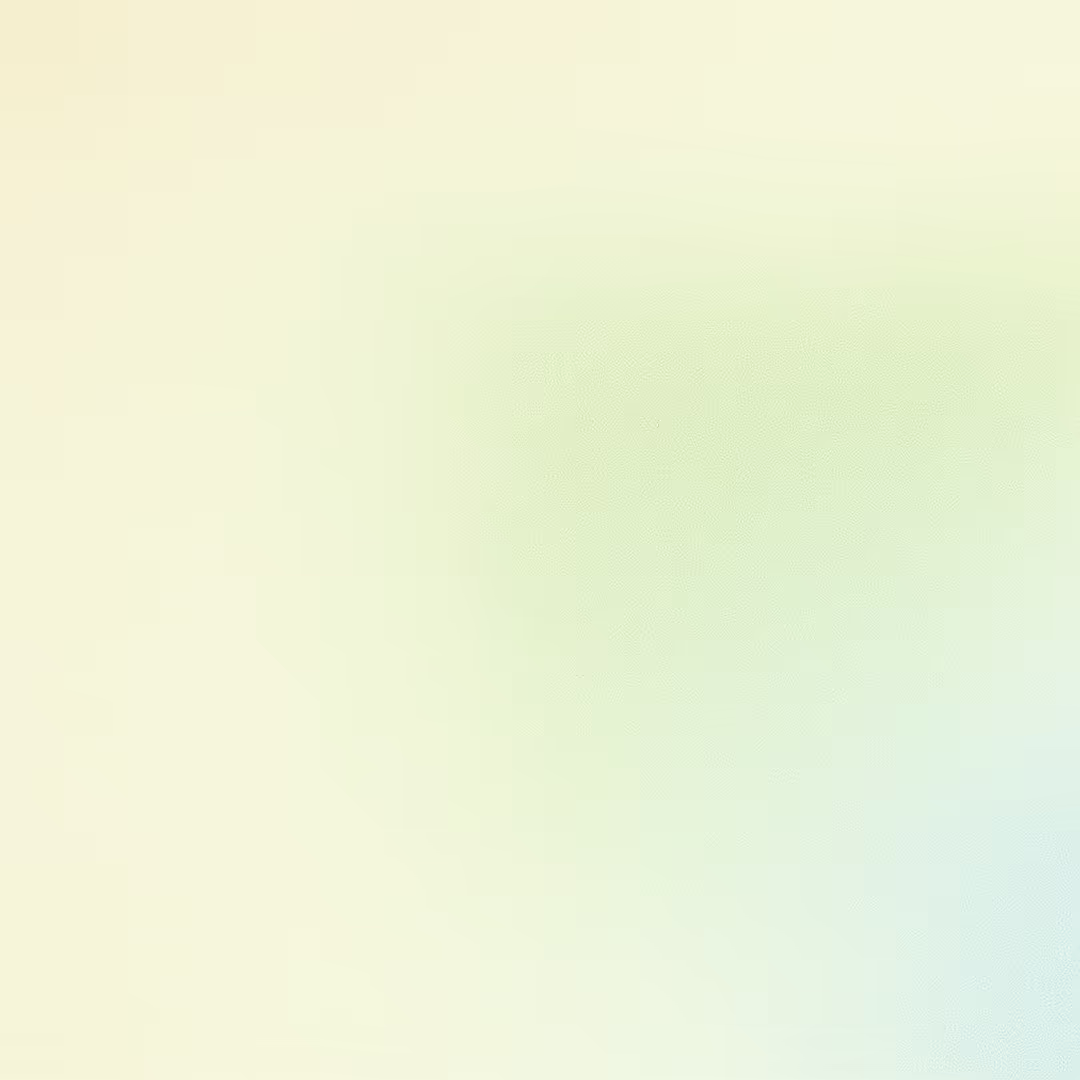A lot of fintech companies are uncomfortable with writing about their competitors.
And yet, writing about your competitors is one of the highest converting types of content you can create.
However, even if you do want to write content about competitors, you might face challenges like:
- Convincing higher ups that it’s ok to write about competitors.
- Having enough information on your competitors.
- Doing it in a way that will keep the compliance team happy.
In this piece, we’ll look into the multiple reasons why it pays to write about competitors, and go into some real examples of top performing content we’ve written. We’ve also included a short guide on how to write competitor content in the best way possible.
Let’s go!
Note: we’re a content marketing agency that helps fintech companies use content for customer acquisition. Learn more about how we do it here: Mint Studios Framework
Why should you write about your competitors?
1. Your customers will compare you to your competitors anyway
Intuitively, you might feel that it’s wrong to write about your competitors. What if a potential client reads about your competitor and then decides to go with them?
The issue with this kind of thinking is that if your target customer was going to switch to a competitor, they would do it anyway – whether you mention your competitors or not.
Think about it: when you go about your day and purchase something online, you probably Google everything. You’ll compare one type of electric bike to another, you’ll do endless research on different hotels to stay at and which coffee machine to buy. So why would you act any differently in a B2B setting?
The point is: whether you like it or not, your target customer is already comparing you to competitors. And if they don’t know who your competitors are, they’ll find out in less time than it took you to read this sentence.
As consumers, we love comparing, reading reviews, weighing up the pros and cons. It’s the same in the business world.
Whether you write about your competitors or not, your customers will find out about your competitors. And if they prefer your competitor, they’ll switch anyway. And if you’re hoping that you can tie them into a contract before they realise, then you’ve got another problem on your hands.
2. You can target people who are close to converting
Anyone who is typing up “Xero vs FreeAgent” or “Brex vs Ramp”, is very close to buying. They already know what their problem is, they’ve established what the solution is and they are now comparing different competitors.
In other words, they are an ideal client. Not targeting these types of prospects is leaving customers, and therefore revenue, on the table.
Here are the conversion rates for three of our clients. Notice for each client, there is at least one “comparison post” in the top five highest converting articles.



Without these comparison posts, our clients would be missing out on many more leads per month from their content.
You might be worried that your product is “too different” to your competitors to be truly compared – and you’re likely right. But remember this: it comes down to how your prospect thinks.
Sure, your product might be very different to a competitors’ and you’re essentially comparing apples to oranges. But your target customer doesn’t see it that way – they might not know that you’re very different. Which is why, we would argue, it’s even more important to write a comparison post to make it clear how you’re different, who you usually work with and when it makes sense to work with you versus a competitor.
3. Those who are searching up comparisons are usually not existing customers
We sometimes get pushback from clients that say that there’s a risk that people who read these articles and are already clients might find out about competitors and then switch.
First of all, as we’ve already established, it’s highly likely that if they were going to do that, they would have done it already. They’ve likely already done their research and have decided to work with you.
Secondly, these comparison articles are targeting potential new customers – in other words, people who are not yet customers. They are actually very often finding out about you for the first time, especially if you write a comparison post that piggybacks off of famous competitors, e.g. “Stripe vs Adyen vs [your product]”.
By targeting people who are not yet customers and maybe not even aware of your brand, you are:
- Putting yourself on the same stage as large incumbents, which is great for brand awareness and credibility.
- Building awareness of your product to people who are not even aware that your product exists (and are highly qualified to becoming customers).
- Acquiring new customers.
This argument showcases that really, there is nothing to lose by writing this kind of article. The worst case scenario is that a potential customer (who didn’t know about your product), finds out about your product (yay, brand awareness), and then chooses to go with a competitor. So you’ve raised brand awareness, but not acquired a customer – that’s better than nothing happening at all. Who knows, they might become a customer later on in their journey!
4. You can make a good case for choosing to pick your product
What’s very important when writing a comparison post is to not bash competitors. Instead, you want to use a comparison post to explain clearly for whom your product is ideal for.
In other words, own the fact that you are not for everyone, but you are excellent for this particular type of person or company.
This is a lot easier to do in a blog post, where you can add a section like “Who are we good for?”. It’s not so easy on a landing page, where you might only talk about your product.
By owning the fact that your product is not for everyone and explaining why, you’re seen in the eyes of the customer as a lot more trustworthy. Which leads us onto the next point…
5. Address the elephant in the room and be transparent
When people are buying your product, there’s an elephant in the room: what are your weaknesses? What are you not so good at?
Many companies will pretend there is no elephant in the room. They’ll say that their spend management tool is great for all types of businesses. That they’re the best invoice financing tool in the country. But customers know that’s not true. They know that there are some things that you might not be so good at – and that’s ok.
As a company, you have two choices:
- You can allow the customer to discover the elephant in the room once they become a customer (which might lead to them losing trust).
- OR, the minute they walk in, you say “Here is our elephant. Do you have a problem with it?”.
For example: if you’re a spend management tool, you can admit that you don’t work well for small companies. Or that you work best for companies that operate only in one country. As an invoice financing tool, you might admit that you don’t work very well for the manufacturing industry.
Ideally, you’re not admitting weaknesses that are inherent to your product (e.g. our spend management tool is bad at spend management) – it’s obviously a lot easier to do this if you have a genuinely good product. Instead, you can just admit what type of companies you don’t work well with, and those that you do work well with.
A comparison post is the best way to do that. By owning the fact that you don’t work with everyone, you’re demonstrating confidence in your product. And when you aren’t scared to talk about your competitors, it shows that you know your product is good and that you aren't afraid to admit that your product is not for anyone.
How to write about your competitors
As we mentioned earlier, you don’t want to bash competitors and you want to make sure the reader leaves trusting you and understanding your product better.
Here are some tips on how to write about competitors in a way that raises awareness and brings in customers:
Write about your product first
If you’re doing this for customer acquisition, then it makes sense to write about your product first – especially since many readers won’t scroll to the bottom of the post.
We like to start off our product with a line like “Since we’re the ones writing this article, we thought we would start with ourselves”. See how we do it in this article for Jeeves:
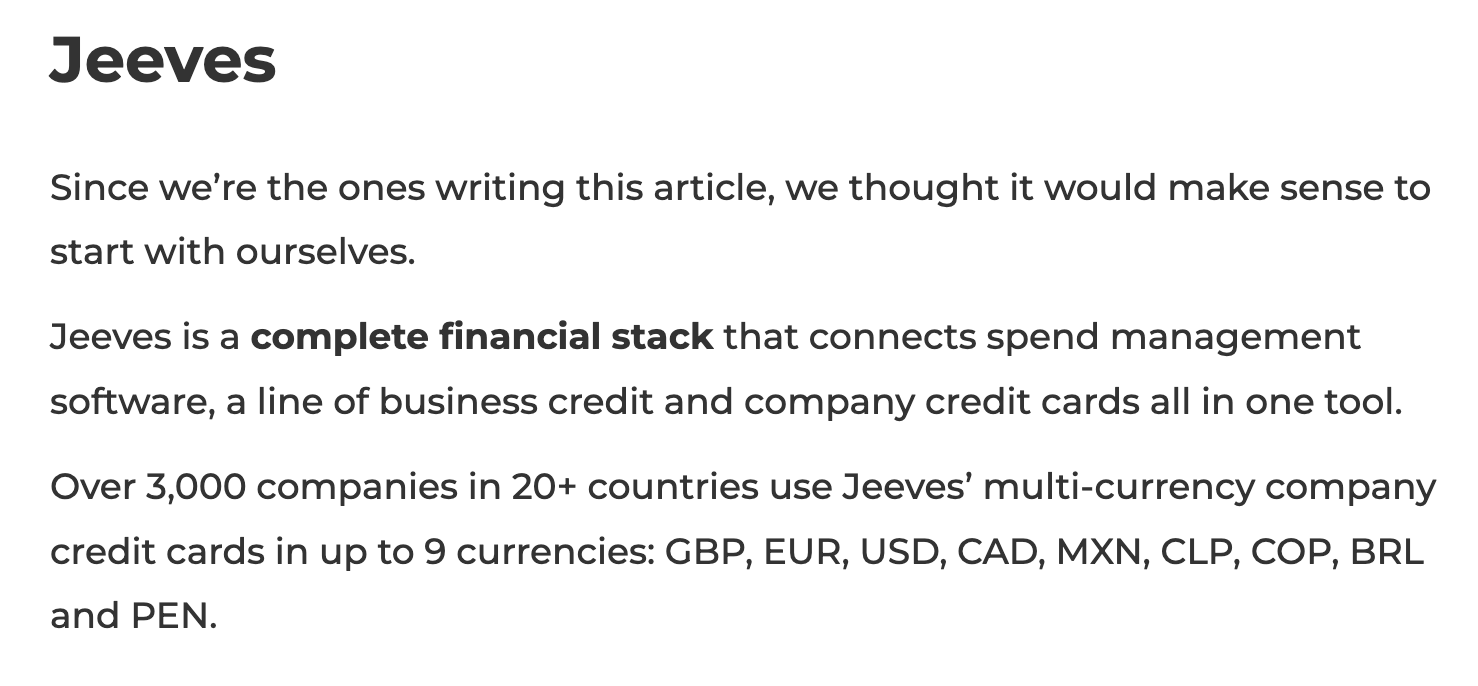
Don’t start off with phrases like “We know we’re biased” or “Of course, we think we’re great…”. It’s just unnecessary and embarrassing, the reader already knows that and they don’t care. They just want the facts.
When you write about your product, go in depth and make sure to include all the features and benefits that someone comparing this product to other competitors would include (this is very important: don’t list all your features, list the ones that someone comparing you to others would care about). Use examples and use cases. Include screenshots.
Add a “Who are we good for?” section, to make it clear who should use your product.
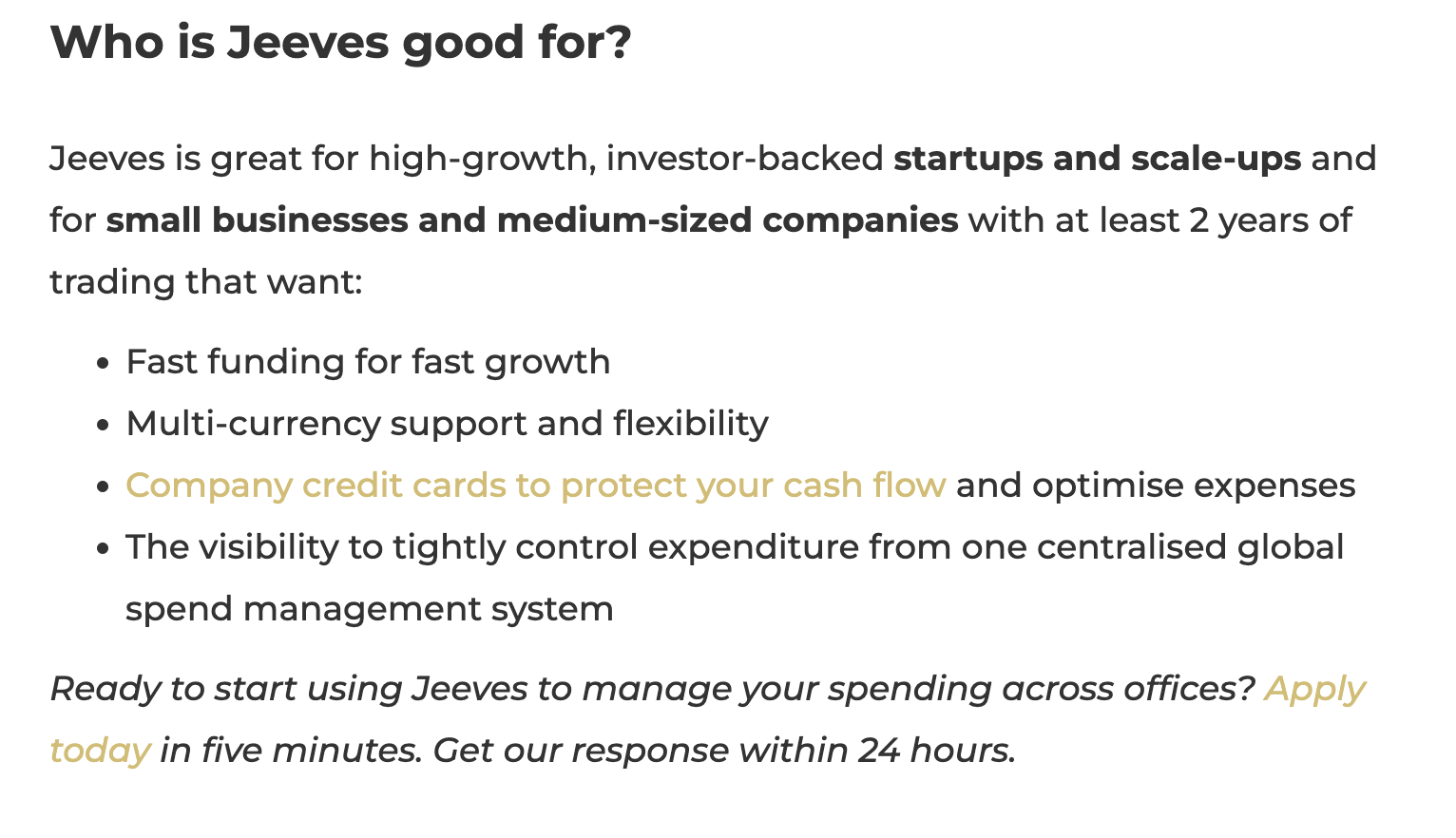
Add the sentence “We understand that our product might not be a good fit for everyone, so it makes sense to talk about competitors”. This does the job of admitting the elephant in the room: that you are talking about competitors, but does it in a way that is trustworthy.

This is where you address your USPs. In this article for Loveelectric, we go in-depth about the key value propositions for the company:

When writing about competitors, only talk about their features
The easiest way to write about competitors is to keep it factual. In other words, avoid opinions, don’t bash them and if you want to be very careful, don’t write anything that cannot be sourced.
Keep it simple: just talk about the features that you would find on their website.
This is especially important if you have to keep compliance happy. If you’re worried about compliance, make sure everything is linked to a source and can be proven.
Exceptions are: if you can interview someone who knows A LOT about your product and your competitors. If that’s the case, then you can go a lot more in depth about your competitors.
If you know your competitors well, add a “Who are they good for” section for them as well, to make it clear how you’re different (and if you have to, find a way to link a source to it).
Write about your cons
If your leadership team lets you, we recommend writing about the cons of your product as well. This helps build trust and shows, once again, that you own the elephant in the room. See how we did that here:
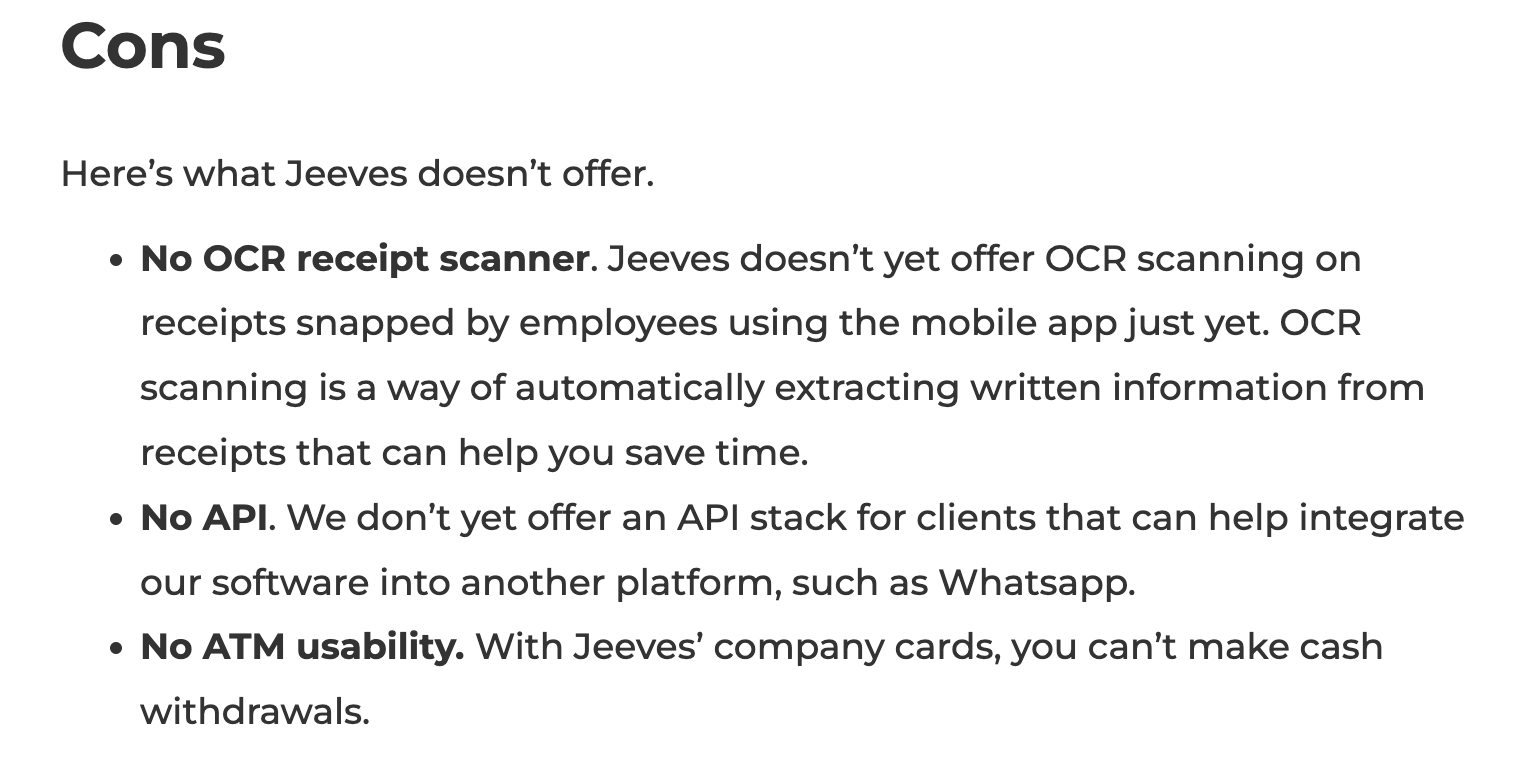
This is what we said earlier about addressing the elephant in the room. Your product clearly has some cons, so if they’re not inherent to your product – why not include them?
And if you want to take it to the next level, write who should not work with you.
Add a “What to look for” section
If you really want to be comprehensive and help out your readers, help them make a decision. They’re evaluating competitors, but honestly, it’s likely that they’re not sure how to compare and contrast different products. What questions should they be asking to decide on the product? What key features should they look for? What are the top use cases?
In certain worlds (e.g. insurance, banking), it’s very hard to get the right information.
So why not help out the reader and give some recommendations on how to do research? Why not help make the decision easier for them?
For this section, you’ll probably want to interview someone on your team who knows what they’re talking about.
Here’s how we did that in this article:

Other tips
- If you’re very uncomfortable with publishing a comparison post on your blog, you can keep it public but hide it from the blog homepage. There’s a way to do that with Webflow. Email us if you’d like to learn how
- Add a table, if you can. This allows the reader at a glance to evaluate certain features
Examples of well performing comparison posts
Here are some examples of articles that performed well for our clients over the years:
Payhawk vs Spendesk vs Soldo vs Jeeves: Which One’s Best for You?
This one is ranking in the first position for “Payhawk vs Spendesk”. Think about what that’s doing for brand awareness.
Adyen vs Stripe vs Zai: Which is best for Australian businesses?
Also ranking on the first page of Google for “Adyen vs Stripe” in Australia.
Best Invoice App for Freelancers in Australia (That'll Help You Get Paid Faster!)
Another type of comparison posts are the “best of [category]” and also perform very well. This one is on the first page of Google in Australia, and puts Parpera on the map.
Best Salary Sacrifice Car Scheme in the UK — Which One is Best for You?
In a highly competitive sector, this puts the challenger brand on the map. This article also does a good job of addressing the elephant in the room and helping readers make a decision.
We hope this article was useful and encourages you to write content about competitors. If your issue relates to convincing your leadership team, send them this article!
Ultimately, the best argument for writing this type of content is: you won’t lose anything by creating this type of content (especially if you hide it from your blog) and you’re likely to get a decent amount of conversions from it. So why not go ahead and do it? 🙂


